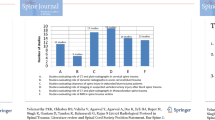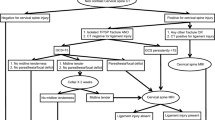Abstract
Because it may cause paralysis, injury to the spine is one of the most feared traumas, and spinal cord injury is a major cause of disability. In the USA approximately 10,000 traumatic cervical spine fractures and 4000 traumatic thoracolumbar fractures are diagnosed each year. Although the number of individuals sustaining paralysis is far less than those with moderate or severe brain injury, the socioeconomic costs are significant. Since most of the spinal trauma patients survive their injuries, almost one out of 1000 inhabitants in the USA are currently being cared for partial or complete paralysis. Little controversy exists regarding the need for accurate and emergent imaging assessment of the traumatized spine in order to evaluate spinal stability and integrity of neural elements. Because clinicians fear missing occult spine injuries, they obtain radiographs for nearly all patients who present with blunt trauma. We are influenced on one side by fear of litigation and the possible devastating medical, psychologic and financial consequences of cervical spine injury, and on the other side by pressure to reduce health care costs. A set of clinical and/or anamnestic criteria, however, can be very useful in identifying patients who have an extremely low probability of injury and who consequently have no need for imaging studies. Multidetector (or multislice) computed tomography (MDCT) is the preferred primary imaging modality in blunt spinal trauma patients who do need imaging. Not only is CT more accurate in diagnosing spinal injury, it also reduces imaging time and patient manipulation. Evidence-based research has established that MDCT improves patient outcome and saves money in comparison to plain film. This review discusses the use, advantages and disadvantages of the different imaging techniques used in spinal trauma patients and the criteria used in selecting patients who do not need imaging. Finally an overview of different types of spinal injuries is given.





Similar content being viewed by others
References
Jenkins MG, Curran P, Rocke LG (1999) Where do we go after the three standard cervical spine views in the conscious trauma patient? A survey. Eur J Emerg Med 6(3):215–217
Pollack CV, Hendey GW, Martin DR, Hoffman JR, Mower WR (2001) Use of flexion–extension radiographs of the cervical spine in blunt trauma. Ann Emerg Med 38(1):8–11
Insko EK, Gracias VH, Gupta R, Goettler CE, Gaieski DF, Dalinka MK (2002) Utility of flexion and extension radiographs of the cervical spine in the acute evaluation of blunt trauma. J Trauma 53(3):426–429
Dwek JR, Chung CB (2000) Radiography of cervical spine injury in children: are flexion–extension radiographs useful for acute trauma? Am J Roentgenol 174(6):1617–1619
Gebhard JS, Donaldson DH, Brown CW (1994) Soft-tissue injuries of the cervical spine. Orthop Rev 23(Suppl):9–17
Woodring JH, Lee C (1993) Limitations of cervical radiography in the evaluation of acute cervical trauma. J Trauma 34(1):32–39
Besman A, Kaban J, Jacobs L, Jacobs LM (2003) False-negative plain cervical spine X-rays in blunt trauma. Am Surg 69(11):1010–1014
Hanson JA, Blackmore CC, Mann FA, Wilson AJ (2000) Cervical spine injury: a clinical decision rule to identify high-risk patients for helical CT screening. Am J Roentgenol 174(3):713–717
Daffner RH (2001) Helical CT of the cervical spine for trauma patients: a time study. Am J Roengenol 177(3):677–679
Woodring JH, Lee C (1992) The role and limitations of computed tomography scanning in the evaluation of cervical trauma. J Trauma 33(5):698–708
Wilmink JT (1999) MR imaging of the spine: trauma and degenerative disease. Eur Radiol 9(7):1259–1266
Flanders AE, Schaefer DM, Doan HT, Mishkin MM, Gonzalez CF, Northrup BE (1990) Acute cervical spine trauma: correlation of MR imaging findings with degree of neurologic deficit. Radiology 177:25–33
Schaefer D, Flanders A, Northrup B et al (1992) Prognostic significance of magnetic resonance imaging in the acute phase of cervical spine injury. J Trauma 76:218
Geck MJ, Yoo S, Wang JC (2001) Assessment of cervical ligamentous injury in trauma patients using MRI. J Spinal Disord 14(5):371–377
Obenauer S, Alamo L, Herold T, Funke M, Kopka L, Grabbe E (2002) Imaging skeletal anatomy of injured cervical spine specimens: comparison of single-slice vs multi-slice helical CT. Eur Radiol 12(8):2107–2111
Griffen MM, Frykberg ER, Kerwin AJ, Schinco MA, Tepas JJ, Rowe K, Abboud J (2004) Radiographic clearance of blunt cervical spine injury: plain radiograph or computed tomography scan? J Trauma 56(2):457
Mann FA, Cohen WA, Linnau KF, Hallam DK, Blackmore CC (2003) Evidence-based approach to using CT in spinal trauma. Eur J Radiol 48(1):39–48
Dai LY, Yao WF, Cui YM, Zhou Q (2004) Thoracolumbar fractures in patients with multiple injuries: diagnosis and treatment. A review of 147 cases. J Trauma 56(2):348–355
Hoffman JR, Wolfson AB, Todd K, Mower WR (1998) Selective cervical spine radiography in blunt trauma: methodology of the National Emergency X-Radiography Utilization Study (NEXUS). Ann Emerg Med 32(4):461–469
Hoffman JR, Mower WR, Wolfson AB, Todd KH, Zucker MI (2000) Validity of a set of clinical criteria to rule out injury to the cervical spine in patients with blunt trauma. National Emergency X-Radiography Utilization Study Group. N Engl J Med 343(2):138–140
Stiell IG, McKnight RD, Wells GA, Lesiuk H, Vandemheen K, Clement C et al (2000) Application of the NEXUS low-risk criteria for cervical spine radiography in Canadian emergency departments. Acad Emerg Med 7:566
Dickinson G, Stiell IG, Schull M, Brison R, Clement CM, Vandemheen KL, Cass D, McKnight D, Greenberg G, Worthington JR, Reardon M, Morrison L, Eisenhauer MA, Dreyer J, Wells GA (2004) Retrospective application of the NEXUS low-risk criteria for cervical spine radiography in Canadian emergency departments. Ann Emerg Med 43(4):507–514
Touger M, Gennis P, Nathanson N, Lowery DW, Pollack CV Jr, Hoffman JR, Mower WR (2002) Validity of a decision rule to reduce cervical spine radiography in elderly patients with blunt trauma. Ann Emerg Med 40(3):287–293
Stiell IG, Clement CM, McKnight RD, Brison R, Schull MJ, Rowe BH, Worthington JR, Eisenhauer MA, Cass D, Greenberg G, MacPhail I, Dreyer J, Lee JS, Bandiera G, Reardon M, Holroyd B, Lesiuk H, Wells GA (2003) The Canadian C-spine rule versus the NEXUS low-risk criteria in patients with trauma. N Engl J Med 349(26):2510–2518
Stiell IG, Wells GA, Vandemheen KL, Clement CM, Lesiuk H, De Maio VJ, Laupacis A, Schull M, McKnight RD, Verbeek R, Brison R, Cass D, Dreyer J, Eisenhauer MA, Greenberg GH, MacPhail I, Morrison L, Reardon M, Worthington J (2001) The Canadian C-spine rule for radiography in alert and stable trauma patients. JAMA 286(15):1841–1848
Linsenmaier U, Krotz M, Hauser H, Rock C, Rieger J, Bohndorf K, Pfeifer KJ, Reiser M (2002) Whole-body computed tomography in polytrauma: techniques and management. Eur Radiol 12(7):1728–1740
Harris JH, Mirvis SE (1996) The radiology of acute cervical spine trauma. Williams & Williams, Baltimore
Rogers LF (1971) The roentgenographic appearances of transverse or chance fractures of the spine: the seat belt fracture. Am J Roentgenol 111:844–849
Goldberg W, Mueller C, Panacek E, Tigges S, Hoffman JR, Mower WR (2001) Distribution and patterns of blunt traumatic cervical spine injury. Ann Emerg Med 38(1):17–21
Cirak B, Ziegfeld S, Knight VM, Chang D, Avellino AM, Paidas CN (2004) Spinal injuries in children. J Pediatr Surg 39(4):607–612
Bensch FV, Kiuru MJ, Koivikko MP, Koskinen SK (2004) Spine fractures in falling accidents: analysis of multidetector CT findings. Eur Radiol 14(4):618–624
Denis F (1983) The three column spine and its significance in the classification of acute thoracolumbar spinal injuries. Spine 8:817–831
El-Khoury GY, Moore TE, Kathol MH (1992) Radiology of the thoracic spine. Clin Neurosurg 38:261–295
Taylor JR, Finch P (1993) Acute injury of the neck: anatomical and pathological basis of pain. Ann Acad Med Singapore 22(2):187–192
Yue JJ, Lawrence BD, Sutton KM, Strugar JJ, Haims AH (2004) Complete cervical intervertebral disc extrusion with spinal cord injury in the absence of facet dislocation: a case report. Spine 29(9):E181–E184
Oner FC, van de Rijt RH, Ramos LM, Groen GJ, Dhert WJ, Verbout AJ (1999) Eur Spine J 8(3):194–198
Chiu WC, Haan JM, Cushing BM, Kramer ME, Scalea TM (2001) Ligamentous injuries of the cervical spine in unreliable blunt trauma patients: incidence, evaluation, and outcome. J Trauma 50(3):457–463
Jackson RS, Banit DM, Rhyne AL III, Darden BV Jr (2002) Upper cervical spine injuries. J Am Acad Orthop Surg 10(4):271–280
Weisskopf M, Bail H, Mack M, Stockle U, Hoffmann R (1999) Value of MRI in traumatic disco-ligament instability of the lower cervical spine. Unfallchirurg 102(12):942–948
Crowe H (1964) A new diagnostic sign in neck injuries. Calif Med 100:12–13
Evans RW, Evans RI, Sharp MJ (1994) The physician survey on the post-concussion and whiplash syndromes. Headache 34(5):268–274
Gunzburg R, Szpalski M, Van Goethem J (2003) Initial assessment of whiplash patients. Pain Res Manag 8(1):24–27
Wallis BJ, Bogduk N (1996) Faking a profile: can naive subjects simulate whiplash responses? Pain 66(2–3):223–227
Van Goethem JWM, Biltjes IGGM, van den Hauwe L, Parizel PM, De Schepper AMA (1996) Whiplash-injuries: is there a role for imaging? Eur J Radiol 22:30–37
Bogduk N, Yoganandan N (2001) Biomechanics of the cervical spine. Part 3: minor injuries. Clin Biomech 16(4):267–275
Van Goethem JWM, Ozsarlak O, Parizel PM (2003) Cervical spine fractures and soft tissue injuries. JBR-BTR 86(4):230–234
Pang D, Wilberger JE Jr (1982) Spinal cord injury without radiographic abnormalities in children. J Neurosurg 57(1):114–129
Hendey GW, Wolfson AB, Mower WR, Hoffman JR (2002) Spinal cord injury without radiographic abnormality: results of the National Emergency X-Radiography Utilization Study in blunt cervical trauma. J Trauma 53(1):1–4
Holmes JF, Mirvis SE, Panacek EA, Hoffman JR, Mower WR, Velmahos GC (2002) Variability in computed tomography and magnetic resonance imaging in patients with cervical spine injuries. J Trauma 53(3):524–529
Sagiuchi T, Tachibana S, Endo M, Hayakawa K (2002) Diffusion-weighted MRI of the cervical cord in acute spinal cord injury with type II odontoid fracture. J Comput Assist Tomogr 26(4):654–656
Belanger E, Picard C, Lacerte D, Lavallee P, Levi AD (2000) Subacute posttraumatic ascending myelopathy after spinal cord injury. Report of three cases. Neurosurgery 93(2 Suppl):294–299
Potter K, Saifuddin A (2003) Pictorial review: MRI of chronic spinal cord injury. Br J Radiol 76(905):347–352
Falcone S, Quencer RM, Green BA, Patchen SJ, Post MJ (1994) Progressive posttraumatic myelomalacic myelopathy: imaging and clinical features. Am J Neuroradiol 15(4):747–754
Peter Vellman W, Hawkes AP, Lammertse DP (2003) Administration of corticosteroids for acute spinal cord injury: the current practice of trauma medical directors and emergency medical system physician advisors. Spine 28(9):941–947
Blackmore CC (2003) Evidence-based imaging evaluation of the cervical spine in trauma. Neuroimaging Clin N Am 13:283–291
Author information
Authors and Affiliations
Corresponding author
Rights and permissions
About this article
Cite this article
Van Goethem, J.W.M., Maes, M., Özsarlak, Ö. et al. Imaging in spinal trauma. Eur Radiol 15, 582–590 (2005). https://doi.org/10.1007/s00330-004-2625-5
Received:
Accepted:
Published:
Issue Date:
DOI: https://doi.org/10.1007/s00330-004-2625-5




